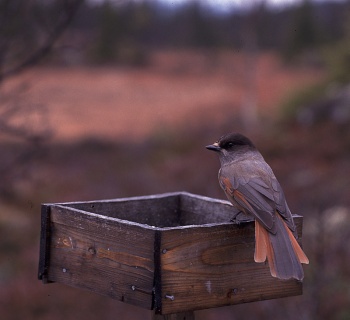Alternative name: Grey Jay
- Perisoreus infaustus
Identification
25 - 31cm. A jay of the northern forests in Europe and Asia:
- Dull and rather loose greyish-brown plumage
- Darker head
- Rusty wing patch and rump
- Rusty long tail with a brown central feather
- Short and small bill
Sexes similar. Juveniles are greyer overall and have a less obvious dark hood.
Distribution
Found from Scandinavia east over the taiga forests of Russia and Siberia to Mongolia and northeast China.
Common to abundant in parts of its large range.
Taxonomy
Nine subspecies accepted:
- P. i. infaustaus from Scandinavia to Finland, Estonia and northwest Russia
- P. i. ostjakoram in northern Russia east to the Lena basin
- P. i. yakutensis in central and east Russia
- P. i. ruthenus in western Russia from St. Petersburg east to Tomsk
- P. i. sibericus in central Russia and northern Mongolia
- P. i. tkachenkoi in the eastern part of south-central Russia
- P. i. opicus in east Kazakhstan, northwest China and south-central Russia
- P. i. caudatus in north-central Mongolia and adjacent Russia (Buryatia)
- P. i. maritimius in eastern Russia (Ussuriland) and northeast China
Habitat
Boreal forest. Prefers dense, mature forest parts with spruce, pines, larches and with stands of birches. Occurs from the lowlands up to 2200m.
Behaviour
Feeds on berries, seeds, insects and other invertebrates. Takes also carrion. Produces a sticky saliva with which it glues together berries and other food items into balls for easier winter storage.
Rather unobtrusive but can be very tame in some areas and even take food from the hand. Usually seen in pairs or family groups.
Breeding season from March to May. Couples stay lifelong together. The nest is a loose structure made of twigs and placed close to the trunk of the tree on a branch. Lays 3 - 4 eggs.
A resident species. Some populations in the extreme north of the range move southwards in winter.
References
- Clements, JF. 2009. The Clements Checklist of Birds of the World. 6th ed., with updates to December 2009. Ithaca: Cornell Univ. Press. ISBN 978-0801445019.
- Del Hoyo, J, A Elliott, and D Christie, eds. 2009. Handbook of the Birds of the World. Volume 14: Bush-shrikes to Old World Sparrows. Barcelona: Lynx Edicions. ISBN 978-8496553507
Recommended Citation
- BirdForum Opus contributors. (2024) Siberian Jay. In: BirdForum, the forum for wild birds and birding. Retrieved 24 October 2024 from https://www.birdforum.net/opus/Siberian_Jay
External Links
GSearch checked for 2020 platform.1





